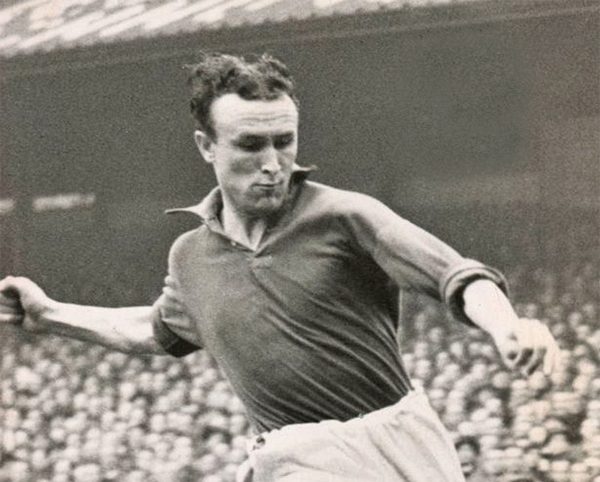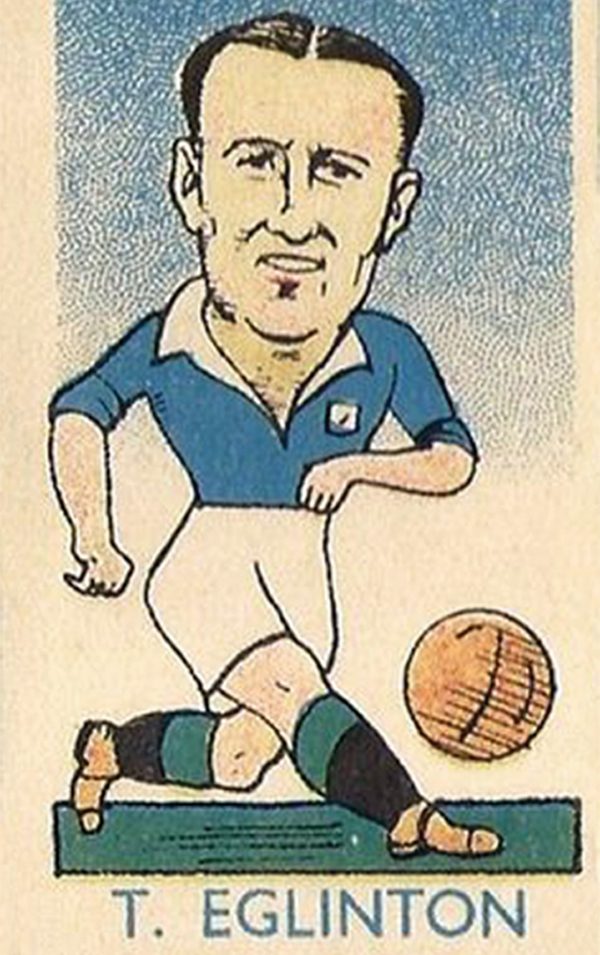
Pictured above: Tommy Eglington in action.
Tommy Eglington was born in January 1927 and when he was fifteen he earned himself a reputation as an exciting footballer when his club Distillery upset the odds by beating the top-level team Bray Unknowns in the 1942 Leinster Senior Cup final.
He was signed by Shamrock Rovers in the same year and did well with them. Rovers won two FAI Cup finals and The Independent praised “the young outside-left who used the ball with the coolness and craft of a veteran.” By the end of the 1945/46 league season he was Rovers’ top scorer and accepted as one of the best wingers in the country.
His obvious talent was noticed by Everton FC who paid Shamrock Rovers £10,000 to sign him in July 1946. He made his debut at the start of the 1946/47 season in a 3-2 win over Arsenal and soon enough the sight of him in the blue shirt of Everton running right-backs ragged became a familiar and pleasurable sight for the fans.
In the late 1940s and early 1950s Irish footballers were eligible for both the Republic of Ireland and Northern Ireland teams. In June 1946 Tommy was picked for his first game for the Republic of Ireland team and though they lost that encounter with Portugal he didn’t look out of place at international level.
He started six consecutive international matches for Northern Ireland between 1946 and 1948. His best performance for them was in the away match against England at Goodison Park, on November 5th, 1947.
The game started quietly. England worked some good chances which had Ireland worried but at half-time they’d kept the match scoreless. After the break, England were awarded a soft penalty, but justice prevailed and the Irish ‘keeper saved it. Then Tommy turned up the heat on England. The Independent said “he struck top form” and “raced through to fire in a great shot” and “minutes later was just wide with another strike.”
His determined, direct running seemed to inspire Ireland and, with only eight minutes left, they took the lead and victory was in sight. But a minute later England equalised, and then with two minutes left in the match they went ahead. It seemed like it would be the same sad old song of defeat for Ireland. With just seconds remaining, however, the Irish forward Doherty knocked a crossfield ball out to the left wing, where Tommy made the space to send a first-time cross straight into the penalty area just as Doherty arrived to meet the pinpoint delivery and hurled himself at the ball to send it stinging into the back of the net with the very last touch of the game. Ireland had the draw and were unbeaten in the 1947 British Championship.
The Republic of Ireland were unsuccessful in trying to qualify for the 1950 World Cup finals in Brazil but were offered the possibility of a place in the tournament by FIFA when Scotland declined to take part.
But the FAI decided that the cost of travelling to South America would be too much, and for the sake of the few bob, Tommy and the team missed out on the chance to be the first Irish team to play at a World cup. Nevertheless, Tommy represented the Republic 24 times over the years, playing and captaining with distinction until 1957.
The 1950s was not a great time for Everton. The club was on a downward spiral and suffered relegation to Division Two in 1951. Tommy was at the peak of his career then and could have gone to a team in the top league but he stayed with Everton and from then on he was a hero to the Everton fans as he settled down to the task of tearing apart opposition defences.
His most memorable game in Division Two was on September 27th, 1952. The place was Goodison Park, the visitors were Doncaster Rovers, and on that cold and windy evening Tommy wrought utter destruction on them, giving a solo show of dazzling offensive thrust and clinical scoring prowess. The goals went in: one, two, three, four and then five goals, all scored by Eglington. Everton won 7-1, and the Liverpool Daily Post said about him: “A better example of practical wing play there could not be.”

Left: One of a series of football cards (with mis-spelt name).
Tommy moved to Tranmere Rovers in June of 1957. Tranmere were down in the third division but Tommy continued to turn in top quality offensive play, scoring 38 goals in 181 games during his three seasons on the Wirral.
In 1961 Tommy joined Cork Hibernians and the 1962/63 season was Tommy’s last as a player, and he made it count with superb performances for Cork in the FAI Cup. He scored in the dying moments of the second round, dragging Hibs through to the semi-final, where he fired a fierce volley to seal their place in the final. He could be well satisfied with what the archive called his “marvellous season.” He retired from football soon afterwards.
Tommy Eglington was the real thing – he played over four hundred games in eleven seasons with Everton, became a club legend and set scoring records that stand today.
Everton fans still speak of their dashing winger who had “the pace that launched 1,000 attacks” and the Liverpool Echo praised his “terrific speed, intricate close control and stunning shooting power.” At home, Tommy is known as one of Ireland’s greatest ever players.
The moment he crossed the white line and stepped onto the pitch you could see that he was more than a little bit special. It’s a pity there aren’t more like him.
By Gavan Bergin



